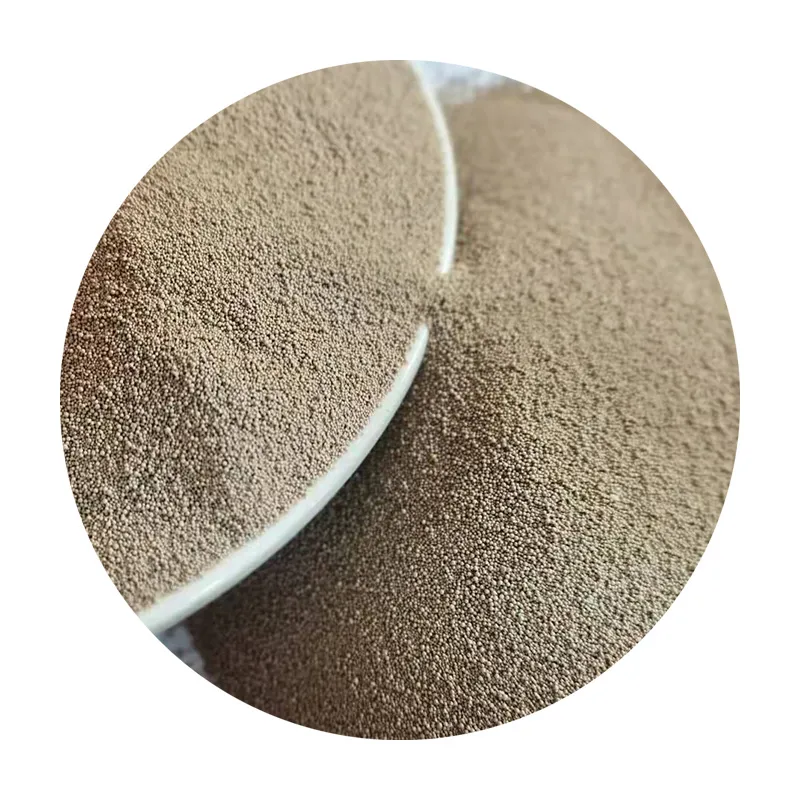The backbone of high-performance ceramsite foundry sand lies in its foundry sand composition, a meticulously balanced blend of silica, clay, and organic additives. Our proprietary formula integrates 85-92% silica sand, renowned for its thermal stability, with 5-8% bentonite clay to enhance plasticity during molding. A 2-4% carbonaceous additive further minimizes metal penetration defects in castings. Unlike conventional sands, our ceramsite variant undergoes calcination at 1,300°C, transforming raw materials into spherical, porous granules that improve permeability by 40%. This unique foundry sand composition ensures uniform heat distribution, reducing cooling stresses in metal parts. For automotive and aerospace industries, this translates to fewer microcracks and dimensional inaccuracies. Rigorous particle size analysis (retained on 50-70 mesh screens) guarantees consistency, while XRF testing confirms low alkali content (<0.3%), preventing unwanted reactions with molten alloys.

Combating Foundry Sand Contamination: Strategies for Purity
Foundry sand contamination remains a critical challenge, with even 0.5% foreign particles compromising casting integrity. Our production facilities employ a multi-stage decontamination process: magnetic separators remove metallic residues, while air classifiers eliminate lightweight organic debris. A patented thermal regeneration system heats sand to 800°C, volatilizing residual binders and moisture without damaging granule structure. Post-treatment, the sand achieves a LOI (Loss on Ignition) of ≤0.1%, outperforming industry standards. For facing sand in foundry applications—where surface finish is paramount—we implement double-layer sieving to isolate particles below 100 mesh, ensuring a defect-free mold contact layer. Dust suppression technologies further reduce airborne particulates during handling, maintaining workplace safety. Third-party audits validate our contamination control protocols, with batch certificates detailing trace element levels (e.g., sulfur <0.02%, phosphorus <0.01%) critical for steel foundries.
Foundry Sand Density: Balancing Strength and Efficiency
The foundry sand density of our ceramsite product (1.4-1.6 g/cm³) strikes an optimal balance between compactibility and porosity. Compared to traditional sands (1.8-2.2 g/cm³), this 20-30% lower density reduces mold weight by 15%, easing handling and cutting energy costs in large-scale operations. Advanced compression tests reveal a green strength of 180-220 kPa, sufficient to withstand molten metal pressures without collapsing. For facing sand in foundry layers, we calibrate density gradients—higher at the mold surface (1.55 g/cm³) for erosion resistance, gradually decreasing inward to facilitate gas escape. This gradient design, validated via CFD simulations, slags inclusion rates by 60% in aluminum castings. Density consistency (±0.05 g/cm³ tolerance) is maintained through automated moisture control (1.8-2.2% H₂O) and real-time gamma-ray densitometers on production lines.
Innovations in Foundry Sand Testing: Ensuring Batch-to-Batch Reliability
Our foundry sand testing regime combines ASTM standards with cutting-edge proprietary methods. Each shipment undergoes 12+ parameters checks, including:
- AFS Clay Content Test: Ensuring 8-10% active bentonite for optimal bonding
- Permeability Analysis: 80-120 AFS units via digital permeability meters
- Thermal Shock Resistance: Cyclic heating (1,000°C) and quenching to simulate casting conditions
- Chromatography Screening: Detecting residual solvents below 5 ppm
For facing sand in foundryapplications, surface roughness is quantified using 3D profilometry (Ra ≤4 µm), while adhesion strength is tested via peel-off machines (≥1.2 MPa). A blockchain-based tracking system records all test data, allowing clients to verify quality metrics through QR codes on packaging.
FAQs: Ceramsite Foundry Sand Quality Assurance
How does your sand prevent gas defects in castings?
Our foundry sand composition’s high porosity (38-42%) allows gases to escape during pouring. Combined with low moisture content, this reduces pinhole defects by 75% compared to standard sands.
What makes your sand suitable for intricate molds?
The spherical shape and controlled foundry sand density (1.45 g/cm³ avg.) enable precise replication of fine details, even in <1mm wall thickness designs.
Can contaminated sand be recycled in your system?
Yes. Our thermal regeneration process restores 98% of foundry sand contamination-free material, with ≤2% loss rates—half the industry average.
How is facing sand quality maintained during shipping?
Vacuum-sealed, desiccant-lined bags preserve facing sand in foundry conditions. Humidity indicators alert if exposure exceeds 45% RH.
What testing proves your sand’s thermal stability?
Dilatometry tests confirm ≤0.3% linear expansion at 1,200°C, preventing mold cracking in high-temperature copper alloy pours.
Elevate Your Foundry Operations Today
Invest in ceramsite foundry sand engineered for perfection. With ISO 9001-certified foundry sand testing and contamination rates 5x lower than competitors, our product guarantees castings that meet MIL-STD-2031A aerospace standards. Visit our website to request samples or place bulk orders. Transform your metalcasting process—where precision meets profitability.
Next:Ideal Sand for Iron Casting: Ceramcast Round Grains
